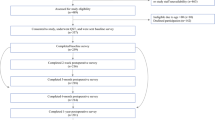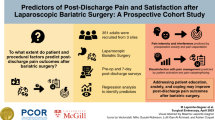Abstract
Background
Obesity and chronic pain (CP) represent serious, interrelated global public health concerns that have a profound impact on individuals and society. Bariatric surgery is increasing in popularity and has been proven safe and efficacious, providing long-term weight loss and improvements in many obesity-related co-morbidities. A decrease in CP is often a motivation for bariatric surgery. The purpose of this study was to investigate the changes in CP postoperatively and to examine the relationship between psychosocial measures and pain.
Methods
A total of 155 adult bariatric surgery patients were recruited and completed self-report measures for CP severity and interference, neuropathic pain, anxiety, depression, emotion regulation and perceived social support at three timepoints preoperative and 6 and 12 months postoperative.
Results
Pain significantly decreased between preoperative and postoperative timepoints, and preoperative pain was the most significant predictor of postoperative pain. Preoperative CP was correlated with anxiety (p < 0.05) and depression (p < 0.01) at 6 months postoperatively and perceived social support (p < 0.01) at 1 year postoperatively. However, regression analyses with psychological variables were not significant.
Conclusion
CP decreases after bariatric surgery, but further research with larger sample sizes is needed to establish whether psychosocial characteristics impact this outcome.
Graphical Abstract


Similar content being viewed by others
References
Mills SE, Nicolson KP, Smith BH. Chronic pain: a review of its epidemiology and associated factors in population-based studies. Br J Anaesth. 2019;123(2):e273–83.
Okifuji A, Hare BD. The association between chronic pain and obesity. J Pain Res. 2015;399–408.
Rogers AH, Farris SG. A meta-analysis of the associations of elements of the fear-avoidance model of CP with negative affect, depression, anxiety, pain-related disability and pain intensity. Eur J Pain. 2022;26(8):1611–35.
Van Hecke O, Torrance N, Smith BH. Chronic pain epidemiology and its clinical relevance. Br J Anaesth. 2013;111(1):13–8.
Eisenberg D, Shikora SA, Aarts E, Aminian A, Angrisani L, Cohen RV, et al. 2022 American Society of Metabolic and Bariatric Surgery (ASMBS) and International Federation for the Surgery of Obesity and Metabolic Disorders (IFSO) indications for metabolic and bariatric surgery. Obes Surg. 2023;33(1):3–14. https://doi.org/10.1007/s11695-022-06332-1.
Panteliou E, Miras AD. What is the role of bariatric surgery in the management of obesity? Climacteric. 2017;20(2):97–102.
King WC, Chen JY, Belle SH, et al. Change in pain and physical function following bariatric surgery for severe obesity. Jama. 2016;315(13):1362–71.
Stefanova I, Currie AC, Newton RC, et al. A meta-analysis of the impact of bariatric surgery on back pain. Obes Surg. 2020;30:3201–7.
Vincent HK, Ben-David K, Conrad BP, et al. Rapid changes in gait, musculoskeletal pain, and quality of life after bariatric surgery. Surg Obes Relat Dis. 2012;8(3):346–54.
Elnahas A, Jackson TD, Okrainec A, et al. The effect of the Ontario Bariatric Network on health services utilization after bariatric surgery: a retrospective cohort study. Can Med Assoc Open Access J. 2016;4(3):E489–95.
Cleeland CS, Ryan KM. Pain assessment: global use of the Brief Pain Inventory. Ann Acad Med Singapore. 1994;23(2):129–38.
Chahal-Kummen M, Blom-Høgestøl IK, Eribe I, et al. Abdominal pain and symptoms before and after Roux-en-Y gastric bypass. BJS Open. 2019;3(3):317–26.
Palanne R, Rantasalo M, Vakkuri A, et al. Fat tissue is a poor predictor of 1 year outcomes after total knee arthroplasty: a secondary analysis of a randomized clinical trial. Scand J Surg. 2023;112(1):22–32.
Gratz KL, Roermer L. Multidimensional assessment of emotion regulation and dysregulation: development, factor structure, and initial validation of the difficulties in emotion regulation scale. J Psychopathol Behav Assess. 2004;26:41–54.
Mishali M, Kisner M. Psycho-behavioral factors related to weight regain after bariatric surgery. Obes Surg. 2022;32(9):3041–6.
Taube-Schiff M, Van Exan J, Tanaka R, et al. Attachment style and emotional eating in bariatric surgery candidates: the mediating role of difficulties in emotion regulation. Eat Behav. 2015;18:36–40.
Spitzer RL, Kroenke K, Williams JBW, et al. A brief measure for assessing generalized anxiety disorder. Arch Intern Med. 2006;166:1092–7.
Cassin S, Sockalingam S, Hawa R, et al. Psychometric properties of the patient health questionnaire (PHQ-9) as a depression screening tool for bariatric surgery candidates. Psychosomaticsomatics. 2013;54:352–8.
Cassin SE, Sockalingam S, Du C, et al. A pilot randomized controlled trial of telephone-based cognitive behavioural therapy for preoperative bariatric surgery patients. Behav Res Ther. 2016;80:17–22.
Portenoy R. Development and testing of a neuropathic pain screening questionnaire: ID Pain. Curr Med Res Opin. 2006;22(8):1555–65.
Sherbourne CD, Stewart AL. The MOS social support survey. Soc Sci Med. 1991;32(6):705–14.
Tarlov AR, Ware JE, Greenfield S, et al. The Medical Outcomes Study: an application of methods for monitoring the results of medical care. JAMA. 1989;262(7):925–30.
Kroenke K, Spitzer RL, Williams JB. The PHQ-9: validity of a brief depression severity measure. J Gen Intern Med. 2001;16:606–13.
Manea L, Gilbody S, McMillan D. Optimal cut-off score for diagnosing depression with the Patient Health Questionnaire (PHQ-9): a meta-analysis. Can Med Assoc J. 2012;184:E191–6.
Sockalingam S, Leung SE, Ma C, et al. The impact of Telephone-Based cognitive behavioral therapy on mental health distress and disordered eating among bariatric surgery patients during COVID-19: preliminary results from a multisite randomized controlled trial. Obes Surg. 2022;32(6):1884–94.
Team RC. R: A language and environment for statistical computing. R Foundation for Statistical Computing. (No Title). (2013).
Dahlhamer J, Lucas J, Zelaya C, et al. Prevalence of CP and high-impact CP among adults - United States, 2016. MMWR Morb Mortal Wkly Rep. 2018;67:1001–6.
Fayaz A, Croft P, Langford RM, et al. Prevalence of CP in the UK: a systematic review and meta-analysis of population studies. BMJ Open. 2016;6:e010364.
Coaccioli S, Masia F, Celi G, et al. CP in the obese: a quali-quantitative observational study. Recenti Prog Med. 2014;105(4):151–4.
Chen LH, Weber K, Mehrabkhani S, et al. The effectiveness of weight loss programs for low back pain: a systematic review. BMC Musculoskelet Disord. 2022;23(1):1–14.
Burr DA, Castrellon JJ, Zald DH, et al. Emotion dynamics across adulthood in everyday life: older adults are more emotionally stable and better at regulating desires. Emotion. 2021;21(3):453–64. https://doi.org/10.1037/emo0000734.
Denny BT. Getting better over time: a framework for examining the impact of emotion regulation training. Emotion. 2020;20(1):110–4. https://doi.org/10.1037/emo0000641.
Author information
Authors and Affiliations
Corresponding author
Ethics declarations
Ethical Approval
All procedures performed in studies involving human participants were in accordance with the ethical standards of the institutional and/or national research committee and with the 1964 Helsinki Declaration and its later amendments or comparable ethical standards.
Informed Consent
Informed consent was obtained from all individual participants included in the study.
Conflict of Interest
The authors declare no competing interest.
Additional information
Publisher's Note
Springer Nature remains neutral with regard to jurisdictional claims in published maps and institutional affiliations.
Key Points
• Chronic pain decreased overall after bariatric surgery.
• Preoperative pain was the most significant predictor.
• A larger sample size is needed to establish if psychosocial factors impact pain decrease.
Rights and permissions
Springer Nature or its licensor (e.g. a society or other partner) holds exclusive rights to this article under a publishing agreement with the author(s) or other rightsholder(s); author self-archiving of the accepted manuscript version of this article is solely governed by the terms of such publishing agreement and applicable law.
About this article
Cite this article
Kastanias, P., Wang, W., Robinson, S. et al. Predictors of Chronic Pain 6 Months and 1 Year After Bariatric Surgery. OBES SURG 34, 1786–1792 (2024). https://doi.org/10.1007/s11695-024-07201-9
Received:
Revised:
Accepted:
Published:
Issue Date:
DOI: https://doi.org/10.1007/s11695-024-07201-9




